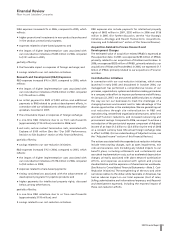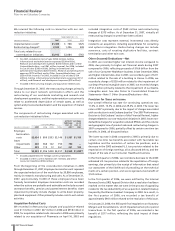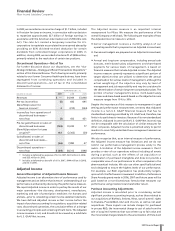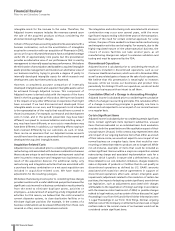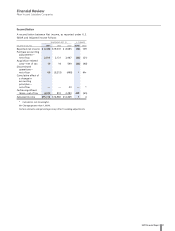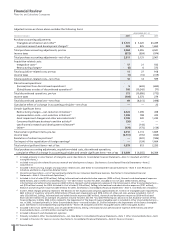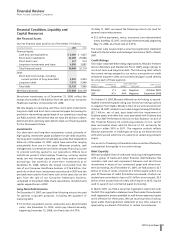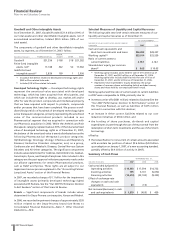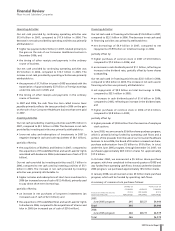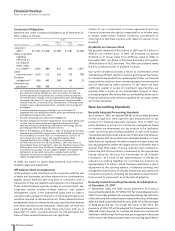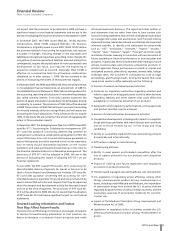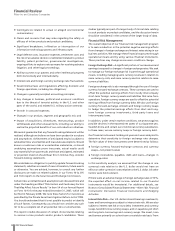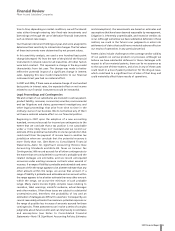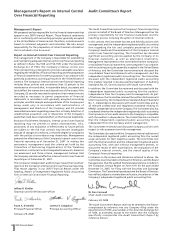Pfizer 2007 Annual Report Download - page 35
Download and view the complete annual report
Please find page 35 of the 2007 Pfizer annual report below. You can navigate through the pages in the report by either clicking on the pages listed below, or by using the keyword search tool below to find specific information within the annual report.
not expect that the provisions to be adopted in 2008 will have a
significant impact on our financial statements and we are in the
process of evaluating the impact of provisions to be adopted in 2009.
In December 2007, the FASB issued SFAS No. 141(R), Business
Combinations. (SFAS 141(R) replaced SFAS No. 141, Business
Combinations, originally issued in June 2001.) SFAS 141(R) retains
the purchase method of accounting for acquisitions, but requires
a number of changes, including changes in the way assets and
liabilities are recognized in purchase accounting. It also changes the
recognition of assets acquired and liabilities assumed arising from
contingencies, requires the capitalization of in-process research and
development at fair value, and requires the expensing of
acquisition-related costs as incurred. Generally, SFAS 141(R) is
effective on a prospective basis for all business combinations
completed on or after January 1, 2009. We are currently in the
process of evaluating the extent of those potential impacts.
In December 2007, the FASB issued SFAS 160, Noncontrolling Interests
in Consolidated Financial Statements, an amendment of ARB 51,
Consolidated Financial Statements. SFAS 160 provides guidance for
the accounting, reporting and disclosure of noncontrolling interests,
also called minority interest. A minority interest represents the
portion of equity (net assets) in a subsidiary not attributable, directly
or indirectly, to a parent. The provisions of SFAS 160 will be adopted
in 2009. The provisions of SFAS 160 will impact our current accounting
for minority interests, which are not significant, and will impact our
accounting for future acquisitions, if any, where we do not acquire
100% of the entity. We are currently in the process of evaluating the
extent of those potential impacts.
In December 2007, the Emerging Issues Task Force (EITF) issued EITF
Issue No. 07-1, Accounting for Collaborative Arrangements. EITF
07-1 provides guidance concerning: determining whether an
arrangement constitutes a collaborative arrangement within the
scope of the Issue; how costs incurred and revenue generated on
sales to third parties should be reported in the income statement;
how an entity should characterize payments on the income
statement; and what participants should disclose in the notes to
the financial statements about a collaborative arrangement. The
provisions of EITF 07-1 will be adopted in 2009. We are in the
process of evaluating the impact of adopting EITF 07-1 on our
financial statements.
In June 2007, the EITF issued EITF Issue No. 07-3, Accounting for
Nonrefundable Advance Payments for Goods or Services to be
Used in Future Research and Development Activities. EITF Issue No.
07-3 provides guidance concerning the accounting for non-
refundable advance payments for goods and services that will be
used in future R&D activities and requires that they be expensed
when the research and development activity has been performed
and not at the time of payment. The provisions of EITF Issue No.
07-3 will be adopted in 2008. We do not expect that the adoption
of EITF Issue No. 07-3 will have a significant impact on our financial
statements.
Forward-Looking Information and Factors
That May Affect Future Results
The Securities and Exchange Commission encourages companies
to disclose forward-looking information so that investors can
better understand a company’s future prospects and make
informed investment decisions. This report and other written or
oral statements that we make from time to time contain such
forward-looking statements that set forth anticipated results based
on management’s plans and assumptions. Such forward-looking
statements involve substantial risks and uncertainties. We have tried,
wherever possible, to identify such statements by using words
such as “will,” “anticipate,” “estimate,” “expect,” “project,”
“intend,” “plan,” “believe,” “target,” “forecast” and other words
and terms of similar meaning in connection with any discussion of
future operating or financial performance or business plans and
prospects. In particular, these include statements relating to future
actions, business plans and prospects, prospective products or
product approvals, future performance or results of current and
anticipated products, sales efforts, expenses, interest rates, foreign
exchange rates, the outcome of contingencies, such as legal
proceedings, and financial results. Among the factors that could
cause actual results to differ materially are the following:
•Success of research and development activities;
•Decisions by regulatory authorities regarding whether and
when to approve our drug applications as well as their decisions
regarding labeling and other matters that could affect the
availability or commercial potential of our products;
•Speed with which regulatory authorizations, pricing approvals
and product launches may be achieved;
•Success of external business development activities;
•Competitive developments, including with respect to competitor
drugs and drug candidates that treat diseases and conditions
similar to those treated by our in-line drugs and drug
candidates;
•Ability to successfully market both new and existing products
domestically and internationally;
•Difficulties or delays in manufacturing;
•Trade buying patterns;
•Ability to meet generic and branded competition after the
loss of patent protection for our products and competitor
products;
•Impact of existing and future legislation and regulatory
provisions on product exclusivity;
•Trends toward managed care and healthcare cost containment;
•U.S. legislation or regulatory action affecting, among other
things, pharmaceutical product pricing, reimbursement or
access, including under Medicaid and Medicare, the importation
of prescription drugs from outside the U.S. at prices that are
regulated by governments of various foreign countries, and the
involuntary approval of prescription medicines for over-the-
counter use;
•Impact of the Medicare Prescription Drug, Improvement and
Modernization Act of 2003;
•Legislation or regulatory action in markets outside the U.S.
affecting pharmaceutical product pricing, reimbursement or
access;
2007 Financial Report 33
Financial Review
Pfizer Inc and Subsidiary Companies


